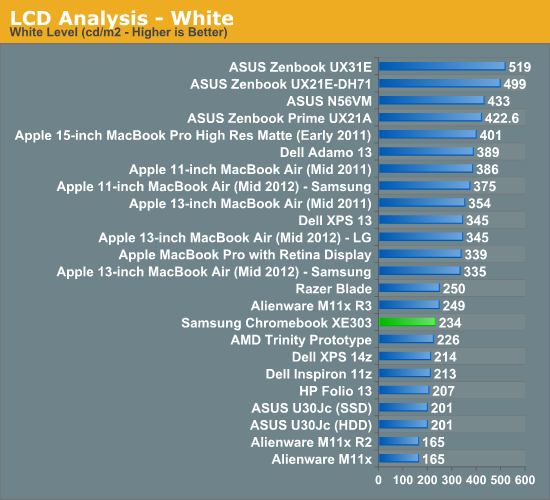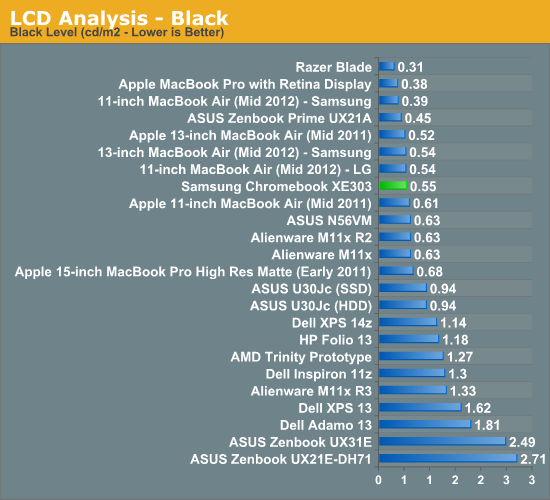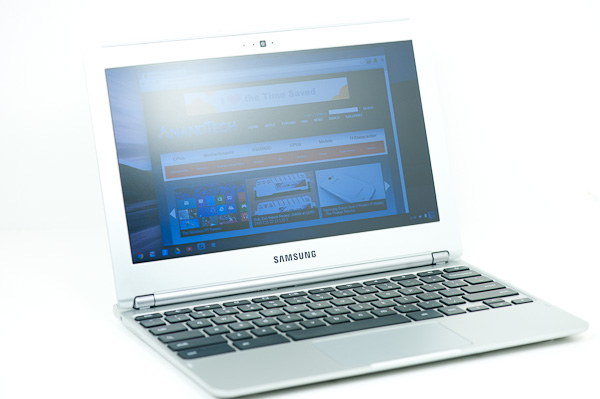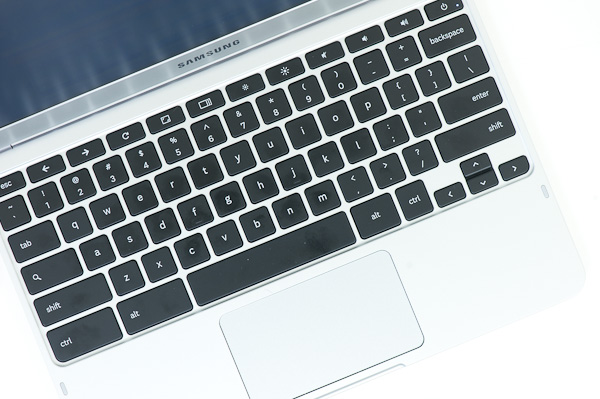Samsung Chromebook (XE303) Review: Testing ARM's Cortex A15
by Anand Lal Shimpi on October 31, 2012 9:00 AM ESTDisplay Quality
The new Chromebook's display is still a fairly mediocre TN panel, but for anyone used to the majority of low cost PC notebooks over the past few years it's really not any different. The 16:9 display measures 11.6 inches along the diagonal with a 1366 x 768 resolution.
Viewing angles are pretty bad. Max brightness tops out at 233 nits, although contrast ratio is better than a lot of low cost notebooks. The low max brightness means that outdoor use will be an issue, generally speaking for really bright sunlight you'll need something closer to 500 nits to be usable.



Given the price tag however, the Chromebook's display is passable. What's more bothersome is that PC makers were fine shipping this quality of a display in systems that were 2x the price of the new Chromebook.
Keyboard & Trackpad
The new Chromebook retains the chicklet keyboard that its predecessors introduced. Key feel is a little mushier than I would like but overall the keyboard is pretty good. There's obviously no backlight, which again is a concession Samsung had to make to hit the Chromebook's aggressive price point.
As this is a Chrome OS device there's no Windows/Apple key alternative, just oversized control/alt keys which I really do appreciate.
Chrome OS' keyboard shortcuts do mimic those of OS X. Ctrl + W will close a Chrome tab/window, and more universally ctrl + L will shift focus to the omnibar. There's a row of shortcut keys at the top of the keyboard. Shortcuts include brightness and volume controls, page forward/back and refresh keys, as well as dedicated keys for maximizing the current window and switching between windows (although alt+tab still works for that as well). There's no capslock key, but a dedicated search key in its place. Perhaps Google doesn't want Chromebook users to contribute to overly capitalized YouTube comments.
None of these aspects of the keyboard are new, they've been around since the first Chromebook. There are no dedicated page up/down, home or end keys unfortunately (although alt + up/down will work as a page up/down replacement).
The trackpad is the weaker of the two input devices on the new Chromebook, and even it isn't all that bad. Tracking accuracy is good, and I never had any unintentional taps. The trackpad is actually a clickpad with no discrete buttons. Two fingers on the clickpad will trigger a right click (a two finger tap and click both work). Two finger scrolling is also supported, although there aren't any other gestures. My biggest problem with the trackpad is its click + drag performance isn't all that good. Compared to some of the garbage that has shipped in much more expensive PC notebooks (and Ultrabooks for that matter), Samsung did a good job with the Chromebook.












149 Comments
View All Comments
Krysto - Thursday, November 1, 2012 - link
Tablets and phones don't boot-up instantaneously. That's waking from idle mode that you're talking about, which basically just means turning on the screen.Krysto - Wednesday, October 31, 2012 - link
When Cortex A7 arrives in big.Little I expect the idle times to drop dramatically in A15 set-ups, and I doubt Intel can keep up with that. Not to mention they still won't keep up in graphics department.Anand, can you stop plugging Surface into Android and Chromebook reviews? Why would I want to hear how Surface might do in the future with this chip that Chromebook already has? Seriously.
Exophase - Wednesday, October 31, 2012 - link
Anand's Cortex-A15 diagram looks really weird vs an official one.. http://regmedia.co.uk/2011/10/20/arm_a15_pipeline_...Three instructions are decoded and dispatched to 5 clusters of 8 execution queues (8 slots each) per cycle, then each cycle each execution queue can issue a cycle to its associated execution unit (note this diagram is using issue/dispatch opposite from how it's often used). There's no execution relationship like given in Anand's diagram, the clusters are: NEON (2x), load/store (2x), simple ALU (2x), multiply, and branch.
Anand Lal Shimpi - Wednesday, October 31, 2012 - link
I based my diagram on a lot of the content in here:http://www.arm.com/files/pdf/AT-Exploring_the_Desi...
Slide 20 introduces the independent issue queues, although subsequent slides make it all a bit more ambiguous (and more like the block diagram you included). I didn't include "issue" width for each of the arrows in my diagram to keep thing simple but I can see that it can definitely give the wrong impression.
Let me see about doing a better pass on the A15 once I'm back from my current trip.
Take care,
Anand
madmilk - Wednesday, October 31, 2012 - link
More proof that ARM ISA isn't magically more efficient than x86 in perf/watt.My i7-3720QM Mac can complete Kraken in 2100ms, with a load power consumption of 30W and idle power of 12W (display on at mid-brightness, discrete GPU off). Ivy has very good power gating, so I'll just assume the CPU is consuming 20W. This results in 42 Joules to complete one run of Kraken. The A15 on the other hand, with a differential of 4 watts (again assuming perfect gating at idle) takes 38.8 Joules. In server usage, perf/watt is king. If the best ARM can deliver is 10% better perf/watt at the expense of 5x per-core performance, they're not going to make a dent against Xeon. I imagine V8 could be optimized more for ARM, but the gains there are not nearly as big as before.
Some other observations -
I ran 8 instances of Kraken at once to make use of all the cores and HT, while reducing the effect of perf/watt-killing Turbo Boost. Power consumption was about 65W total, or approximately 55W going into the CPU. Each Kraken finished in about 3700ms, so what we have is 55W*3.7s/8 = 25 joules per Kraken. Much better, but obviously an apples-to-oranges comparison against the A15 which should probably have two instances run on it for optimal efficiency.
Also, shame on Intel/Samsung/Google for the Chromebook 500. 12W idling for a netbook is just ridiculous.
I don't think we can pull the 32nm vs 22nm fab card here either, because Intel has always been ahead in this respect and the gap is widening.
lemonadesoda - Wednesday, October 31, 2012 - link
The new chromebook is a near-winner! While it is targetting impulse purchase, low-budget buyers, and 2nd world economies, they should consider a 1st world premium buyer audience. If this had a better quality screen with "retina" pixel density, I would buy one in a heartbeat. I don't want to game... I want to read my PDFs without having to zoom to make the text legible... and with the SD card reader... it would be a perfect image display device for the SD cards once it comes out of the camera. 1366x768 is very 2009, not 2012.ol1bit - Wednesday, October 31, 2012 - link
I don't understand why Chrome OS continues at all?Just slapping JellyBean on this hardware would have much more functionality.
andrewaggb - Wednesday, October 31, 2012 - link
Only google can answer this question....Kinda like Firefox OS... or whatever they are calling it. Just not sure what the point is. Maybe they figured linux needs just a few more radically different distributions :-)
ssddaydream - Wednesday, October 31, 2012 - link
Please, will somebody ban this clown?ShaneMickey, that is...
ssddaydream - Thursday, November 1, 2012 - link
...there will be support that would allow AndroidOS, Linux, or Windows RT to be installed and properly functioning on this device.